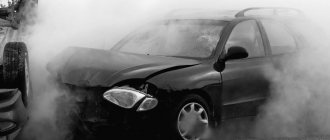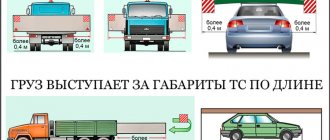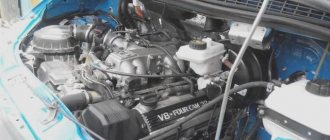After an accident, not surprisingly, the cars are left in a very damaged condition. The insurance company can determine the total loss of the car under compulsory motor liability insurance (otherwise known as total) with damage ranging from 65 to 80%. According to OSAGO, a car is considered “lost” if the cost of repairs is equal to or greater than the price of the vehicle at the time of the insured event.
For example, before the accident, your car (taking into account the fact that it was in use) cost 300 thousand rubles. Repairing it after an accident will require 350 thousand rubles. This means that we can assume that the car cannot be restored, this is its complete destruction. In this case, the insurance company will pay you the value of the car before the accident, reduced by the price of the spare parts remaining suitable for further use. That is, if suitable spare parts cost 30 thousand rubles, then you will receive 300 thousand - 30 thousand rubles. = 270 thousand rubles. It turns out that it is in the interests of the insurance company to significantly reduce the insurance amount; for this they inflate the cost of the remaining spare parts.
Another way to solve the problem is to transfer the lost car to the insurance company and receive the full insurance amount.
When it comes to an expensive car, the situation is different. The full insurance amount for compulsory motor liability insurance is 400 thousand rubles. (for all). In this case, if the car cost 900 thousand rubles, its repair after an accident will cost 930 thousand rubles, and the price of suitable spare parts is 300 thousand rubles (900,000 - 300,000 = 600,000), then the insurance company will, at best, pay only 400 thousand roubles. instead of the expected 600 thousand, and the remaining amount will have to be recovered from the culprit of the accident through the court. Important : after a fire there are practically no usable spare parts left; the insurance company pays the insured amount in full at the cost of the car at the time of the insured event.
What does total mean after an accident?
In the most general and simple case, total loss of a car after an accident occurs when the vehicle is destroyed structurally:
- it was torn apart
- it burned down
- “wrapped” around a pole or tree,
- turned over onto the roof and tumbled until it was completely destroyed.
In this case, everyone understands that it will not be possible to restore the vehicle and its technical characteristics. There is only one way out - scrap metal.
But in some cases, even minor damage at first glance can lead to total liability under compulsory motor liability insurance, for example, if the car’s roof was damaged or the airbags fired.
But there is also an “economic total”!
This concept in most cases appears in insurance cases under compulsory motor liability insurance, since such an event occurs more often than constructive loss of a car.
The very concept of “economic” is a colloquial term intended to immediately draw the attention of the car owner to what is being discussed. And we are talking about the costs of restoring the vehicle. Thus, economic total loss is simply a procedure for calculating payment when it becomes unprofitable for the insurer to restore the car.
When determining whether a car “died” after an accident or not, the expert first approximately, when inspecting the vehicle, and then during the examination, decides whether it is economically feasible or inappropriate to repair and restore this car. If it is not practical to repair it, then they say that the car is a complete loss.
For the purposes of compulsory motor liability insurance, total loss refers to cases where repair of a damaged vehicle is impossible or the cost of repair is equal to or greater than the value of the car at the date of the accident.
What is total
Total loss of a car under compulsory motor liability insurance (total) is an insured event when the car is declared unsuitable for repair or its restoration is considered financially impractical.
Experts rely on regulatory documents that stipulate cases of establishing the complete (constructive) loss of a vehicle:
- restoring a car costs more than its average market value before the accident;
- Complete restoration of the car is technically not possible.
The first paragraph applies when the cost of restoration work exceeds the percentage threshold of the insured amount individually established by each company (the value of the car at the time the policy was issued):
- Rosgosstrakh - 65%;
- Agreement - 70%;
- Ingosstrakh - 75%;
- RESO - 80%.
This means that a vehicle with an insured value of 100,000 rubles, requiring restoration repairs in the amount of 70,000 rubles, will be considered completely destroyed in some companies, while in others insurance payments will be made as usual.
The last point is considered if:
- parts and components that require replacement are no longer produced by anyone (on old cars);
- It is impossible to carry out body work due to multiple corrosion damage at the welds.
Refund procedure. What to do and what will happen next?
The procedure for applying for insurance compensation under MTPL remains the same.
- You submit an application to the insurance company for insurance compensation or direct compensation for losses (depending on the specific situation) with a full set of necessary documents.
- The insurer is obliged to inspect your car within 5 working days. Since we are talking about whether it is a total car or not, such a vehicle most likely cannot participate in road traffic, and therefore the insurer is obliged to inspect the car at its location, that is, somewhere near your house, in garage or parking lot. There is no obligation to transport the car to the insurer on a tow truck. Even if the insurer says that it will compensate for the costs, I would not do this, since the insurance company will simply deduct the costs of the tow truck from the amount of the payment (after all, the law actually allows them to underpay 10% of the damage).
- In general, within 20 calendar days, the insurer is obliged to organize restorative repairs of your car (issue you a referral for repairs, according to which the car will be repaired) or pay insurance compensation. If it is a total loss, then no repairs can be made and payment is made only in cash.
- Within the same period of 20 days, the insurance company is obliged to report a refusal if it makes such a decision. In this case, the refusal must be motivated.
As you can see, everything here is very simple and standard!
How to receive payment for the total loss of a car
In case of total destruction of a car in order to receive compensation under compulsory motor liability insurance, the actions of the car owner do not differ from the standard ones.
Step 1
Immediately after an accident, an insurance worker and a traffic police inspector are called. Before their arrival, detailed photographs and video recording of the consequences of the accident and damage to both cars are carried out. Exchange information with the driver of the second car:
- basic data of civil passports;
- information from the insurance policy, the number of the special sign (attached to the windshield).
Step 2
They carefully monitor the correct location of the vehicles on the protocol diagram drawn up by the traffic police officer. Disagreement is indicated when signing the protocol.
Step 3
On the same day, you need to request a document confirming the fact of the accident from the police department. It must indicate all damage caused to the car at the time of the accident.
Step 4
An application for compensation for damage is submitted to the insurance company within three days. The following documents are attached to it:
- passport;
- TIN;
- driver's license;
- PTS and STS of the car;
- power of attorney for the right to drive this vehicle (if available);
- certificate received from the traffic police;
- OSAGO policy;
- a certificate from the hospital;
- confirmation of forced expenses after an accident (tow truck).
If there are doubts about the accuracy of the damage assessment by insurance specialists, the application insists on conducting an independent examination. Until an expert assessment of the damage is carried out, repair work is prohibited.
Step 5
The insurance company responds within 20 days. If you disagree with the decision, a pre-trial claim is first sent to the company, and then a lawsuit is filed in court.
Step 6
An amount satisfactory to both parties is transferred to the victim’s card within 90 days.
If payments are not made on time or are not made in full, the policyholder has legal grounds to request payment of penalties from the insurer.
How to calculate how much I will be paid?
We have already found out that in case of total compulsory motor liability insurance a payment is due, because this is directly stated in paragraph 16.1 of Article 12 of the Law on Compulsory Motor Liability Insurance. But how much will this payment be?
How much will I receive?
For all cases, we can immediately say with confidence that they will pay no more than the insured amount for compulsory motor liability insurance, which is established by paragraph b of Article 7 of the Law on Compulsory Motor Liability Insurance, that is, no more than 400,000 rubles. This amount cannot be increased, even if the damaged car was much more expensive.
Please note that we are talking specifically about compensation under OSAGO. The missing amount can still be recovered from the person at fault for the accident. More on this below.
How is the cost of a car calculated?
If the car was badly damaged, then it is possible that there were victims in the accident, and therefore you can wait a very long time for documents from the traffic police or the court. Accordingly, the price of cars may either increase or fall during this time.
However, the cost of the car is still calculated on the date of the accident. Even if it was a year ago or two.
This price is determined by the cost of analogue cars, which are taken from information and reference materials. If there are no such materials, then the expert has the right to independently calculate the cost of the analogue using the methods usually used for this type of examination. In practice, in most cases, experts make calculations based on data from sites selling used cars such as avito.ru, auto.ru, etc.
Payment calculation
In cases where the insurer has determined that the insured event is total, the payment is calculated in accordance with clause 18 of Art. 12 of the Law on Compulsory Motor Liability Insurance, namely the difference between the cost of the car at the time of the accident and the cost of the usable remains.
Let's give an example! At the date of the traffic accident, the victim’s car was 2 years old, and its market value was 1,500,000 rubles.
The victim was forced to sue the insurer due to the refusal of compensation. As a result of winning the court, the payment was made, but it was delayed due to litigation for 1 year. And the same three-year-old car costs on average 1,200,000 rubles.
As a result of the accident, the cost of all usable remains was calculated for a total of 600,000 rubles.
In this case, the victim receives... No, not 900,000 rubles, as many thought - 400 thousand.
The calculation here is simple:
- the market value of the car for calculating the total under compulsory motor liability insurance is taken as of the date of the accident - this is 1.5 million rubles,
- then we subtract the valid balances in the amount of 600 thousand and get 900 thousand payable,
- but the maximum insured amount of compensation cannot exceed 400,000 rubles, and therefore the victim receives exactly this limit.
Total loss (total) of a car under compulsory insurance
In all these cases, the vehicle is considered unrecoverable, lost or totaled. Total loss of the car under compulsory motor insurance and comprehensive insurance Attention When the insurer recognizes the total loss of the car, 2 options appear:
- Give the car into the ownership of the insurer with a reduction in the insurance payment by the amount of wear and tear.
- You can keep the car, but along with wear and tear, the cost of any remaining parts will be deducted from your insurance.
Of course, the cost of these leftovers will be greatly inflated.
It is worth keeping the car if it can still be restored or sold at a profit. If the wear is still small, for example, 2 months, then choose the first option.
Then only 2% of the cost will be subtracted from the amount of CASCO insurance. If you disagree with the insurer’s assessment of the recognition of the total, an independent examination can be appointed. If the difference is significant, feel free to file a lawsuit against the insurance company.
Options for payment under CASCO in case of total loss of a car In case of constructive loss of a vehicle, there are 2 main options for compensation under CASCO: Total loss of the vehicle. To avoid this, a car owner whose car was declared unfit for use should consider the following important points:
- Whether this car was repaired under the current insurance policy until it was completely damaged;
- How much time is left until the expiration of the insurance contract;
- This is how much all the parts needed to completely restore the vehicle will cost;
The listed points directly determine the amount of compensation that the driver will receive if the vehicle is declared a total loss.
The rules provided for in this chapter apply regardless of whether unjust enrichment was the result of the behavior of the acquirer of the property, the victim himself, third parties, or occurred against their will. Example for compulsory motor liability insurance 2021. Before the accident, the vehicle was worth 300,000 rubles. The cost of repairs to restore it is 350,000 rubles. Constructive death of a car under compulsory insurance According to the market, such a car, and naturally not in such a vehicle, cost no more than 130-140 thousand rubles.
However, let's try to understand this problem. For clarity, let’s take the following situation: You are a victim of an accident.
Before the accident, your car was worth 4,000 USD. As a result of the accident, the car was damaged; according to the results of an independent assessment, restoration repairs amount to 4100 USD. The cost of suitable remains is 700 USD. The insurance company wants to pay only 3300 USD.
(4000-700). The insurance company’s argument is as simple as 3 kopecks: if we pay you the full amount and you still have the remains of the vehicle (4000,700), then in total this will exceed what you had before the accident (4000), which means you cannot pay it that way.
- average market value (market) 500,000 rub.
- the cost of repairs with wear and tear is 300,000 rubles. without wear 520,000 rub.
- suitable remains - 150,000 rub.
That is, the insurance company has two payment options, and now you yourself will understand which one she will choose: A) 350,000 rubles. - recognize the “total” and pay according to the formula market - year-ends = 500,000-150,000 B) 300,000 rubles. If the car owner has no accidents and has a sufficiently long driving experience, then the MTPL agreement will cost him less.
Let's say this hardware is sold for 50 thousand rubles, the victim is in the black by 150 thousand.
rubles, but the insurance company is naturally in the red.
To clarify, we list the types of vehicles that are subject to this tariff:
- Motorcycles (sports, standard and heavy);
- Light and heavy ATVs;
- Scooter;
- Mopeds (even homemade ones);
- Motor scooters, etc.
How to find out the base rate of OSAGO? Below is a table from which any vehicle owner can determine the basic tariff for 2018.
There are, of course, certain reasonable limits, beyond which such a game will be meaningless, since the car is really a mess and any even more or less thinking person will understand that there is a “total” with no options.
Repair or payment under compulsory motor liability insurance after 04/28/2018 Search by topic Repair or payment after 04/28/2018 The damage to my car is extensive, probably a lot hidden, but it’s definitely far from total.
“Hidden” are indicated in the accident report. Car 2007 My policy was issued in May 2021, the culprit’s policy was issued in October 2021. Law “On OSAGO”, “OSAGO Rules” from the Central Bank of the Russian Federation, etc.
Weigh the advantages and disadvantages before you decide.
Insurance rules regulated by law do not provide for any deductions from this amount, however, in practice, insurance companies take every opportunity to significantly reduce the amount of insurance compensation. If the car is destroyed, the cost of repairs may exceed its cost many times, which will exceed the maximum insurance amount. Of course, insurers cannot agree to this.
Total for compulsory motor insurance how many percent 2018
Thus, for transport classified as “C” and “CE”, which has an acceptable cargo transportation rate of no more than 16 tons, the new tariffs provide for a range of 5284-6341 rubles.
For reference: until April 12, 2017. this tariff was in the range of 2495-2632 rubles.
The only difference is the size of the indicators from the tariff range. Here for transport that belongs to categories “A” and “M” (as well as their subcategories), starting from 04/12/2017.
the rate when concluding a car title agreement will be determined based on the size of the corridor 867-1579 rubles. The result is again: “without money and without a car.” Of course, the policyholder will receive some funds, but his CASCO insurance will not fulfill its main purpose - it will not maintain the client’s material well-being at the same decent level.
Calculation of the total for MTPL 2021 Calculation of the total for MTPL 2018 The policyholder receives the accrued amount and the balance of his car. 2. In this case, if you sell a car for spare parts, they can cost 3 times more than your car in disrepair. In all these cases, the vehicle is considered unrecoverable, lost or totaled.
Thus, the basic insurance rate is at a level that ensures that the amounts paid by car owners for issuing compulsory motor liability insurance slightly exceed the amounts paid by the companies that issued the policy when insured events occur.
- The inflation rate is important because this parameter varies somewhat from year to year.
After all, the law provides a corridor for this value, which means that in companies that take the lower limit of this range as the base coefficient, the price of a car license will be lower. Additionally, we remind you that you should choose an insurance company with a good reputation in order to protect yourself from the possibility of receiving a “fake policy.” You can additionally save on your car license by developing accident-free driving skills (you can get a discount for this).
As stated above, the owner can dispose of older vehicles at his own discretion, for example, sell or buy a similar car, and make a donor out of a damaged vehicle, especially if you have space to store a second car. By the way, we buy “bitishes”, if you are interested, here is the contact form.
And the payment itself under compulsory motor liability insurance in case of complete loss of the vehicle is calculated as the difference between the market value of the vehicle at the time of the accident and the age of the vehicle.
When it is beneficial for the insurer to recognize the constructive loss of a car under compulsory motor liability insurance. Everything is simple here, and the game with calculations is based on the statement that the younger the car, the higher the value of its usable remains. Therefore, in most cases, insurance companies are happy to recognize the car as total in order to pay less, because they pay according to the formula (the market is good). In addition, using our calculator, determine the exact price of a car insurance policy.
From life, they did not recognize the death of the vehicle and underpaid me. I was cut off at a traffic light, there was a strong blow to the front right wheel and fender, as a result of which the car flew onto the lawn, jumping over the curb. The insurance company paid 85,400 rubles, then came for an additional examination, I organized my own experts, but the insurance company did not pay anything more. I think that during the first payment they did not recognize the “total”, why there was no additional payment after the 2nd inspection, only God knows.
Then only 2% of the cost will be subtracted from the amount of CASCO insurance. Payments for the total loss of a car under compulsory motor liability insurance differ from payments under CASCO.
These differences are enshrined in Government Decree No. 263 of May 7, 2003 on the approval of the rules for civil liability insurance of motorists. It states that the amount of payments under compulsory motor liability insurance is determined by the actual value of the car at the time of death. Including if the cost of repairs exceeds the value of the car before the accident.
In other words, MTPL payments do not depend on the amount of wear and tear and other factors included in CASCO insurance.
The maximum amount of payments is set at 400 thousand rubles. Insurance companies may assign additional deductions, citing illegal enrichment (when the cost of payments exceeds the value of the vehicle).
But in this case, enrichment is approved by law and by the very terms of the insurance contract.
You can also challenge this amount through an independent expert. Ask him to calculate, in addition to the damage, the cost of the usable remains. Then send your claims to court.
In case of refusal to pay the vehicle insurance company, the insurance company may claim that in the event of a complete loss of the vehicle, the amount of the insurance payment is paid minus the cost of the usable remains.
However, let's try to understand this problem. For clarity, let’s take the following situation: You are a victim of an accident.
Before the accident, your car was worth 4,000 USD. As a result of the accident, the car was damaged; according to the results of an independent assessment, restoration repairs amount to 4100 USD.
The latest changes to this document came into force on April 12, 2015. The reason for abuses on the part of the insurance company in this case is the lack of a unified methodology for calculating usable balances. Since the determination of the amount of payment for such an insured event depends on the time of its occurrence, at the initial period of the policy the option of full payment may be beneficial for the car owner.
- or the market itself will make more than the cost of repairs without taking into account wear and tear (RUB 520,000)
- make the cost of repairs excluding wear and tear less than 500,000 rubles. (market)
- Clause 1, part 1, article 333.19 of the Tax Code of the Russian Federation determines the amount of duty as follows:
- “up to 20,000 rubles - 4 percent of the claim price, but not less than 400 rubles;
- from 20,001 rubles to 100,000 rubles - 800 rubles plus 3 percent of the amount exceeding 20,000 rubles;
- from 100,001 rubles to 200,000 rubles - 3,200 rubles plus 2 percent of the amount exceeding 100,000 rubles;
- from 200,001 rubles to 1,000,000 rubles - 5,200 rubles plus 1 percent of the amount exceeding 200,000 rubles;
- over 1,000,000 rubles - 13,200 rubles plus 0.5 percent of the amount exceeding 1,000,000 rubles, but not more than 60,000 rubles.”
- Copies of documents confirming ownership of the car.
- Registration of the incident.
- Submitting documents to the insurance company.
- Damage assessment.
- The insurance company's proposal regarding the amount of compensation.
- 1 The concept of “total”
- 2 Total according to OSAGO
- 3 Total under CASCO
- 4 Procedure
Is it possible to recover the missing amount of payment from the culprit?
The good news from the example above is that you can recover the rest of the amount of 500 thousand directly from the tortfeasor - the culprit of the accident.
The calculation of the payment was given above solely for the purposes of compulsory motor liability insurance, but as we know, the difference can be recovered from the at-fault driver if the payment under compulsory motor liability insurance does not cover the damage in full.
And here we have bad news for you. In this case, a new methodology of the Ministry of Justice is used to determine this damage. It describes the new rules for conducting forensic automotive technical examinations, which experts must follow in 2021.
According to this methodology, if the cost of restoration repairs plus the cost of loss of marketable value (LCV) is greater than or equal to the market value of the car before damage, then the damage is considered equal to this market value.
As you can see, there are contradictions. For the purposes of compulsory motor liability insurance, the value of the usable remains is deducted from the cost of the vehicle, and in cases of recovery of the difference from the culprit or damage (when the culprit did not have a compulsory motor liability insurance policy), the market value of the car is reimbursed.
But, fortunately or not, our courts smooth out this contradiction with their decisions and do not compensate the market value of the car in full if there are usable remains. They are motivated, in particular, by the fact that the owner of the damaged car will receive unjust enrichment. Judicial practice in such cases is, as a rule, unambiguous - here is one of such decisions, and here is another.
However, we cannot exclude the possibility that the court may decide to recover the full cost of the vehicle from the tortfeasor, but with the transfer of the usable remainder to the person responsible for the accident. And let him try to implement them. Such judicial practice also exists in 2021.
When is it profitable for an insurer to recognize a constructive loss of a vehicle?
Due to the significant number of foreign cars on our roads, prices for spare parts for them have increased, and, accordingly, losses in an emergency situation have increased. Depending on their interests, insurance companies increase or decrease the cost of spare parts and repairs in order to create a semblance of car destruction. For example, it is beneficial for the insurer to recognize an almost new car with minor damage as lost, because in this case the client can refuse the car in favor of the insurance company, thanks to which they significantly underestimate insurance payments. The lack of approved methods for calculating the value of a car in a pre-accident condition and the possibility of accurately calculating the value of remaining usable spare parts plays into the hands of insurance companies.
If you are sure that the insurance company is deliberately underestimating the amount of money paid, then you should contact experienced lawyers who will tell you what to do in this situation. A prerequisite will be the involvement of independent experts in resolving this controversial issue.
It is especially beneficial for insurance companies to recognize the constructive loss of almost new cars. Spare parts for them are very expensive, and payments are made according to the following scheme: market value minus the cost of suitable spare parts. The only exception may be completely new cars, for the purchase of which there are receipts and contracts.
All actions of the insurance company have certain regulations. The insurer may significantly delay the moment of the final decision, citing additional examinations or delaying the work of the car service to clarify the diagnosis of damage. The insurance company may offer to conclude additional agreements on the sale of a salvage car to third parties, but you cannot agree to this, since you will have nothing to show in court - you yourself agreed!
Will the car be taken?
Insurance under compulsory motor liability insurance differs from voluntary insurance under CASCO, including in that, if the car is recognized as total, no one will take away what is left of it.
But there are also disadvantages to this, because the victim receives less money, since the cost of the usable remains is deducted. And you stay with them and think for yourself how and to whom you will sell them!
What are usable leftovers?
If the car was damaged very badly, but not completely destroyed, then serviceable parts, components and assemblies remain in it, which have some value and can be used in the future, provided that they can be dismantled.
In order for components, components or assemblies to be classified as usable residues, the following conditions must be met:
- under total compulsory motor liability insurance, they should not have damage that violates their integrity,
- must be in marketable condition and in working condition;
- they should not have any holes, cutouts or other structural violations, including for attaching any non-standard equipment;
- the parts must not have been previously repaired.
What if I don't need leftovers?
There are situations when a car that is relatively intact is recognized as total, but due to its low market value and expensive original parts, it is considered completely lost for calculating damage. This often happens with old cars, for which the prices for spare parts and parts according to a single calculation method are expensive.
In this case, of course, it makes sense to repair the car and continue to use it further.
But if the car is structurally damaged or very seriously damaged, then it’s more expensive to deal with the remains. But, unfortunately, you will most likely have to deal with these balances, since the law does not provide for the transfer of usable balances to the insurer under compulsory motor liability insurance.
Thus, the victim is not given the right to choose - to keep intact parts and spare parts for himself and receive a smaller payment, or to give them to the insurer and receive money for them too. Unfortunately, the prerogative of choice belongs to the insurance company.
But you can try to recover their value from the culprit and transfer these balances to him, although no clear judicial practice has emerged on this issue in 2021, and it is not clear whether you will win such a case or not. After all, you can spend money, time and effort on court, but in the end you still have to sell the rest yourself.
Actions of the driver in case of total loss of the car
If it so happens that upon the occurrence of an insured event, the car was insured under the CASCO program and it is recognized as not subject to restoration, then the car owner should prepare for difficult and lengthy compensation for damage. And in this situation, you may encounter a large number of nuances, knowledge of which will help save both nerves and time.
Let's remember that CASCO is primarily voluntary vehicle insurance. That is why the state cannot influence to any extent the presence of mandatory clauses in this agreement. But when you sign all the documents with the insurance company, carefully study all the information specified in them. The main clause in all documents is the clause regarding compensation for damages.
Here are a few more points, the study of which will also be useful when concluding a CASCO agreement:
- situations in which the car will be considered lost, including the percentage ratio of the market value of the vehicle and the amount of damage caused in which the vehicle will be considered dead;
- whether the degree of wear and tear will be deducted during the period when the insurance is in force;
- do they have a practice of concluding a policy with a deductible;
- which party to the contract will pay for the tow truck services;
- which party bears the costs of obtaining the necessary documentation, etc.
Another key point is the situation when an insured event occurs, the car is considered completely destroyed. So what should we do? As a rule, at this moment most owners fall into a stupor.
But there are only two subsequent options for the development of events. The first is when the motorist receives everything that is left of his car, and the insurer makes an additional payment. Second, the insurer provides the motorist with compensation payments in the amount that the car was worth.
Is it possible to refuse and challenge total loss under compulsory motor liability insurance?
If you believe that the MTPL insurer incorrectly calculated the damage and unreasonably “totalized” your seemingly entire car, then you have the right to argue and disagree with this calculation of the insurer.
What if we do an independent examination?
When determining the amount of damage and the amount of payment or repair, the insurer will conduct an independent examination, in which the expert will make the appropriate calculation.
Accordingly, in order for you to have a reasoned argument with the insurer, you also need to have an independent examination, but due to new trends in the legislation on compulsory motor liability insurance, you may not be reimbursed for the costs.
In 2021, there is a mandatory procedure for contacting the insurer with a statement of disagreement, which does not imply the provision of an independent examination. And in the future, when contacting the financial ombudsman, there is also no obligation to provide an expert opinion, since the financial ombudsman himself has the right to conduct an examination and determine the amount of damage.
If you do carry out such an examination, then be prepared for the fact that the costs of conducting it will not be reimbursed to you.
As a result, it may turn out that the last word in your case will be with forensic experts, and then it is better that they have at their disposal not your independent examination, but at least photographs of the inspection of the car, from which they can correctly calculate everything.
Insurers usually do not conduct a detailed inspection of the damaged vehicle, and their calculation may not be objective, but if you do a high-quality inspection, which will record not only the damaged elements, but also whole usable remains, or, conversely, those that were not damaged in the accident , but they cannot be classified as valid balances, then the amounts may be different.
Payment options
If the loss of the vehicle is constructive, then there are 2 options for cash payments under CASCO. The first option is that after the damage to the car has been assessed and the car is considered completely destroyed, the damaged car is returned to the driver, and the insurer pays you a sum of money, from which the amount for wear and tear on the car is deducted.
For example, a driver insures his car, which costs 1 million rubles. If an insured event occurs, the damage caused is estimated at 750 thousand rubles. 10 months have passed since the occurrence of the insured event, so the cost of wear and tear on the car is deducted from this amount. So in the end, the total amount of payments will be 675 thousand rubles. And in this situation, the car owner keeps the remains of the car, which he can later sell.
The second option is that after the car is considered completely destroyed after an insured event and has already been assessed, the remains of the car are transferred to the insurance company. In this case, the insurance company will pay the car owner the full amount as compensation, only depreciation is excluded from it. So if we consider the previous example, then in this situation the car owner receives a sum of money in the amount of 900 thousand rubles.
Which of the two options is more preferable to the car owner is up to him to decide. But he can make any choice. But in the first case, insurance companies try to inflate the cost of suitable remains for their own benefit. Indeed, in this situation, the amount that they will be obliged to pay to the owner of the car will decrease.
But for some car owners, this option is preferable, since few people want to store the remains of the car, and besides, according to the law, when the car owner transfers ownership of the car to the company, cash payments are made without taking into account depreciation, and this is almost 100%.
But insurance companies try to refuse these offers, since the insurance contract often states that monetary compensation is paid taking into account depreciation. But if you look at the judicial practice in these cases, you will notice that most litigation, where the company refuses to reimburse the full cost of the vehicle, is almost always resolved in favor of the car owners.
Can I request repairs?
If, according to the calculation of the insured event, the result is a complete loss, then it is pointless to demand that the car be repaired.
This rule is expressly stated in the MTPL Law, and payment must be made in money.
But you can always try to negotiate. For example, you can agree to use original used spare parts or new, but analogues that will be cheaper than the originals. In this case, perhaps the insurer and the service will agree to repair your car instead of recognizing the total.
But do not forget about the economic benefits of insurance companies. First of all, they will do what is most profitable for them in terms of money:
- if it makes more sense to pay, they will pay,
- If it is repaired, then it will be repaired.
Fortunately, they don’t have to worry about the client, since compulsory motor liability insurance is mandatory for everyone.
Does the insurance company take the car with total insurance under compulsory motor liability insurance?
If the car is completely destroyed, the owner has the right to decide how to dispose of the usable (surviving) remains. The details can be transferred to the insurance company for sale or kept for yourself.
Related article: Features of MTPL insurance rules in 2019
If the valid balances are transferred to the insurer, the driver receives the full insurance payment. If the motorist keeps the parts, their cost will be deducted from the compensation amount. In both cases, the insurer will take into account the percentage of depreciation specified in the MTPL agreement.
Insurance companies often cooperate with companies that sell damaged cars. Then the insurance company can offer the policyholder another option - to help sell the usable balances through its partners, and transfer the money to the client. In this case, these funds will be deducted from the compensation amount.
If the driver chooses the option of assistance in implementation, then it is recommended to study the reputation of the partner office. Sometimes insurance companies work with dubious companies that underestimate the cost of sales. If the driver leaves the usable remains for himself, then he can dispose of them at his own discretion - sell them himself or try to repair the car.
Is it possible to restore a car after a total and drive it?
Yes, you can, but as usual, with conditions. You need to not only repair the car in your own way, but you need to restore its technical characteristics so that it meets the safety requirements and requirements for its operation.
Otherwise, after its sale to the new owner, such a car may not be registered with the traffic police.
Will I get compulsory motor liability insurance for a total car?
Yes. You can even buy a damaged car from someone, which was considered total by the insurance company, and restore it to the desired condition. In this case, there should be no issues with concluding a compulsory motor liability insurance agreement. The insurer, among other things, can inspect the car before concluding a contract and make sure of its integrity and performance.
But in 2021, more and more policies are purchased electronically, so even a car inspection can be avoided.
Is it possible to cancel the insurance after the total?
If you do not plan to restore the car, then you can terminate the MTPL contract and return part of the amount for insurance, this is stated in paragraph 1.13 of the MTPL Rules.
It would be more correct to say that you cannot terminate, but the contract is terminated early and without your desire by force of law.
But in reality this does not always happen. After all, the rules indicate the destruction (loss) of a vehicle, and as we have already found out, a total car is not always completely lost. It may be unprofitable to restore it from the point of view of the legislation on compulsory motor liability insurance, but no one can limit your right to do this, even though it is expensive. And if the car can be restored, then it was not destroyed or lost, and therefore the contract cannot be terminated.
But in practice, if you want to terminate the contract and return part of the funds for the unused period, the insurer does not have the right to refuse you.
Underestimation of the amount of payments under CASCO
Insurance companies often do not shy away from various incorrect methods of calculating cash payments. And that is why, in many cases, the amounts of money that must be paid to policyholders are reduced several times. And this is done for one simple purpose - if the car is not recognized as completely lost, then the cost of monetary compensation increases exponentially.
In addition, there is one provision in the rules on compulsory motor liability insurance, which states that the insurance contract ends when the car is destroyed, and if the car is not recognized as destroyed, then it will have to be restored, and this immediately increases the chances of an insured event occurring in the future, and It's simply not beneficial for companies.
As a rule, they try to underestimate the amount of cash payments based on the cost of repairs, so the higher the cost of repairs, the lower the compensation for losses. And companies are trying in every possible way to increase repair costs. One of the most popular methods is the recognition of serviceable residues that cannot be repaired.
Another equally popular method is to change the formula for calculating the cost of payments. Insurance companies also often manipulate the market value of a car before an insured event occurs. Insurers are trying in every possible way to increase the wear and tear of car parts, such as tires, engine and brake parts, etc.
Most of the actions of insurance companies contain the intent to deceive their clients. But in order not to fall into their fraudulent calculations and tricks, it is worth calculating the market value of the car and the usable balances yourself. You can do this in several ways, for example, calculate it yourself (but not everyone can do this), or simply seek help from specialists who will conduct an examination.
And you should never neglect questions to the insurer; ask him everything, down to the smallest nuances, check all the documents and especially the calculations. If you were able to find an error in the contract and are trying to prove that you are right, but the insurance company does not make concessions, then it is better to go to court.
The insurance company itself terminated the policy - what should I do?
Insurers successfully take advantage of inconsistencies in wording when they benefit. They terminate the contract on their own, often without even informing the policyholder about it. They replace the concept of destruction (loss) with complete destruction, which is used only for the purpose of calculating the amount of damage and in no way indicates that the vehicle cannot be restored or cannot be used in the future for its intended purpose.
What to do if your insurance company has terminated your MTPL contract? The procedure is approximately this:
- receive written confirmation (response) from the insurer about when and on what basis the contract was terminated;
- submit a statement of disagreement to the insurance company and demand that the contract be recognized as valid - here the insurer most often either will not respond to such a letter or will send a refusal, citing the total amount for compulsory motor liability insurance;
- submit an appeal to the financial ombudsman regarding this dispute (but here, with a 99% probability, the financial ombudsman will answer that he does not consider non-financial claims against the insurer, but such an appeal will help save time if you are turned away in court and sent to the financial ombudsman);
- Then all that remains is to go to court to protect your rights - the statement of claim must indicate that the insurer is being forced to recognize the contract as valid.
Well, in any case, the insurer, if it recognized that the contract had terminated, was obliged to pay you the cost of insurance for the unused period. In this case, the date of termination of the contract for calculating days will be the date of the accident.
If you found out about the termination after a new accident?
This also happens in practice in 2021, when the insurer may not fulfill its obligations and not notify the policyholder that the compulsory motor liability insurance agreement has ceased to be valid after the total. And just terminate it.
And you will find out that his liability is not insured only after a new accident. In the best case, when you apply for payment under the PPV from your insurer, in the worst case, when the victim files a claim against you for damages, as against the culprit without compulsory motor liability insurance.
In the first case, you can use the algorithm described above, but demand everything as in the usual refusal of the insurer to make insurance compensation, that is:
- insurance compensation,
- penalty,
- fine,
- TCB...if you deserve all this.
Fortunately, there is already judicial practice in such cases. Here is an example of a case in which the cassation instance explained to the appellate judges that the victim was right and the insurer was wrong, and upheld the court's decision.
In the second case, you will immediately find yourself in court, bypassing all the pre-trial “dancing with a tambourine.” In court, it is absolutely tedious to involve your insurer as a third party and prove that the contract has not terminated and that the actions of the insurance company are not based on the law. The above-mentioned Definition 3 of the Court of Cassation of General Jurisdiction can be used as a guide.
Procedure for receiving payment
To receive compensation for the total loss of your car under compulsory motor liability insurance, take the following steps:
- together with another participant in the accident, draw up a Europrotocol, take a photo or video recording the location and damage to the vehicles;
- or, if there are victims or more than two vehicles were involved in the accident, call the traffic police inspectors to register the accident, draw up a report, and identify the person at fault;
- submit an application to the policyholder;
- provide the car for inspection within 5 days;
- wait for the results of the examination;
- receive payment.
If there is an underestimation of the amount of payment by the insurer, order an independent examination.
The fact that the insurance company admits that the car cannot be restored can also be challenged by an independent expert. For example, an expert can determine whether the insurance company deliberately overestimates the cost of repair work in order to recognize the full total and pay the owner a lesser amount.
It is important to understand! Sometimes it is more profitable for an insurance company to recognize a total car than to engage in expensive and time-consuming repairs. Do not agree to the total until you are completely confident in the correctness of the calculations and the legality of the specified payment amount.
If the owner has no questions about the amount, payment of the insurance compensation will be made 2-4 weeks after signing the agreement with the total.
If you are sure of deliberate understatement of amounts, apply to the court to protect your financial interests.
For its own benefit, the insurer may terminate the contract itself without notifying the client. Hire an auto insurance lawyer. He will prepare a claim, procedural documents, study the results of the examination, and analyze the prospects of the case.
The lawyer will represent the client’s interests in a dispute with the insurance representative in court.
I have a comprehensive insurance policy - can I apply after submitting an application for compulsory motor liability insurance?
As was already said at the very beginning of our article, the conditions under CASCO agreements, as a rule, differ from the conditions of compulsory motor liability insurance. If the latter are prescribed primarily in the law, then the former depend largely on the contract itself. And in each specific situation it may be more profitable to apply either under CASCO or OSAGO.
If you find out that you will receive more money under CASCO after you have submitted an application under MTPL, you can refuse and withdraw this application, unless, of course, the insurer has not yet paid the insurance compensation. After all, it is legally impossible to receive money twice for the same car.











